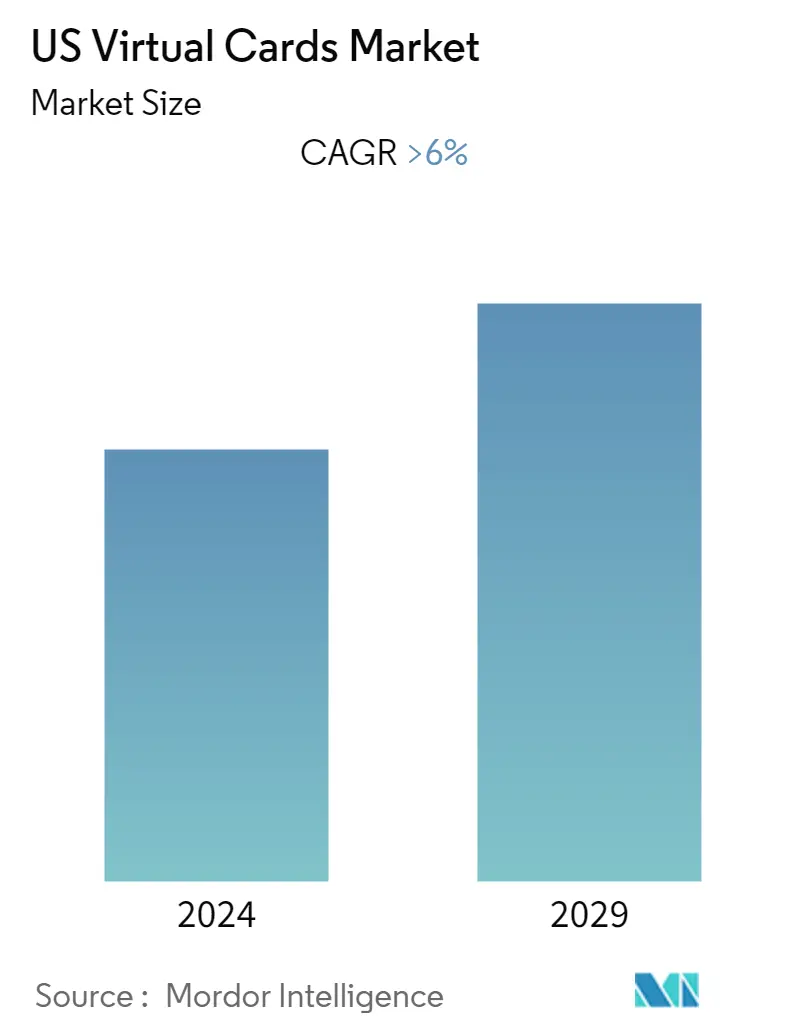Market Size of US Virtual Cards Industry

| Study Period | 2020 - 2029 |
| Base Year For Estimation | 2023 |
| Forecast Data Period | 2024 - 2029 |
| Historical Data Period | 2020 - 2022 |
| CAGR | 6.00 % |
| Market Concentration | Medium |
Major Players.webp)
*Disclaimer: Major Players sorted in no particular order |
US Virtual Cards Market Analysis
The lock-down issued by the United State's Government amid COVID-19 had a detrimental effect on the financial sector. The number of electronic payment transactions or digital payment transfers has decreased from both enterprises and customers as a consequence of the lockdown, which has directly affected the virtual card industry in the United States.
Virtual Cards have become a reliable option for majority of the US citizens as switching to virtual cards has made online shopping secure and easy, and reduces the possibility of crime. While purchasing online, workers essentially locate the object they would like to purchase and send a request to their manager for approval. The manager then produces a virtual certificate for the amount ordered and gives it to the employee who puts the information on the billing screen at checkout. In such a situation, the organization retains complete access and power over the sales method, whilst the employee has the right and autonomy to perform the transaction as normal.
Much of the growth in commercial cards has been observed in large and middle market organizations. The larger corporates, businesses with revenues of USD 1 billion and upwards, were the earliest adopters of commercial cards. Dynamic middle market businesses are now increasingly also looking to move away from inefficient manual processes and make the switch to digital. Across both large and middle markets, however, there are a raft of drivers of the growing interest in commercial cards. These businesses often look for higher levels of automation and the more advanced technology they associate with commercial cards .
US Virtual Cards Industry Segmentation
A virtual card is a digital payment system that functions as a token, and is used for electronic payments and mobile orders. Credentials are created automatically by a method called tokenization, and the cards come with built-in financial controls to finance the card for either single-use or multi-purpose transactions. US Virtual Cards Market is segmented By Product Type and By End-User. By Product Type, the market is segmented into B2B Virtual Cards, B2C Remote Payment Virtual Cards, B2C POS Virtual Cards. By End-User, the market is segmented into Consumer Use and Business Use.
| By Product Type | |
| B2B Virtual Cards | |
| B2C Remote Payment Virtual Cards | |
| B2C POS Virtual Cards |
| By End-User | |
| Consumer Use | |
| Business Use |
US Virtual Cards Market Size Summary
The US virtual cards market is experiencing significant growth, driven by the increasing adoption of digital payment methods and the rising use of smartphones. The shift towards virtual cards has been accelerated by the need for secure and efficient online transactions, particularly in the wake of the COVID-19 pandemic. Virtual cards offer a streamlined process for online purchases, allowing employees to make transactions with managerial oversight, thereby enhancing security and control. This trend is particularly evident in large and middle-market organizations, where there is a growing demand for automation and advanced technology solutions associated with commercial cards. The expansion of internet access, even in non-urban areas, and the rise of e-commerce, supported by technologies like AI and machine learning, are further propelling the demand for virtual cards.
The market is characterized by a few major players, such as American Express, JP Morgan Chase, Billtrust Inc., Abine Inc., and VISA, who dominate the landscape and pose stiff competition to newer entrants. Recent developments, such as Visa's partnership with Safaricom to launch a virtual card for M-Pesa users and American Express's collaboration with Billtrust to streamline virtual card payments, highlight the ongoing innovation and strategic partnerships within the industry. These initiatives aim to enhance the user experience and expand the reach of virtual card solutions, catering to the growing number of electronic transactions and the increasing trend of cashless payments in the United States.
US Virtual Cards Market Size - Table of Contents
-
1. INDUSTRY DYNAMICS AND INSIGHTS
-
1.1 Market Overview
-
1.2 Market Drivers
-
1.3 Market Restraints
-
1.4 Industry Attractiveness - Porters 5 Force Analysis
-
1.4.1 Threat of New Entrants
-
1.4.2 Bargaining Power of Buyers/Consumers
-
1.4.3 Bargaining Power of Suppliers
-
1.4.4 Threat of Substitute Products
-
1.4.5 Intensity of Competitive Rivalry
-
-
1.5 Insights on Impact of Technology and Innovation
-
1.6 Impact of COVID-19 on the Market
-
-
2. MARKET SEGMENTATION
-
2.1 By Product Type
-
2.1.1 B2B Virtual Cards
-
2.1.2 B2C Remote Payment Virtual Cards
-
2.1.3 B2C POS Virtual Cards
-
-
2.2 By End-User
-
2.2.1 Consumer Use
-
2.2.2 Business Use
-
-
US Virtual Cards Market Size FAQs
What is the current US Virtual Cards Market size?
The US Virtual Cards Market is projected to register a CAGR of greater than 6% during the forecast period (2024-2029)
Who are the key players in US Virtual Cards Market?
American Express, JP Morgan Chase, Billtrust Inc., Abine Inc. and VISA are the major companies operating in the US Virtual Cards Market.

